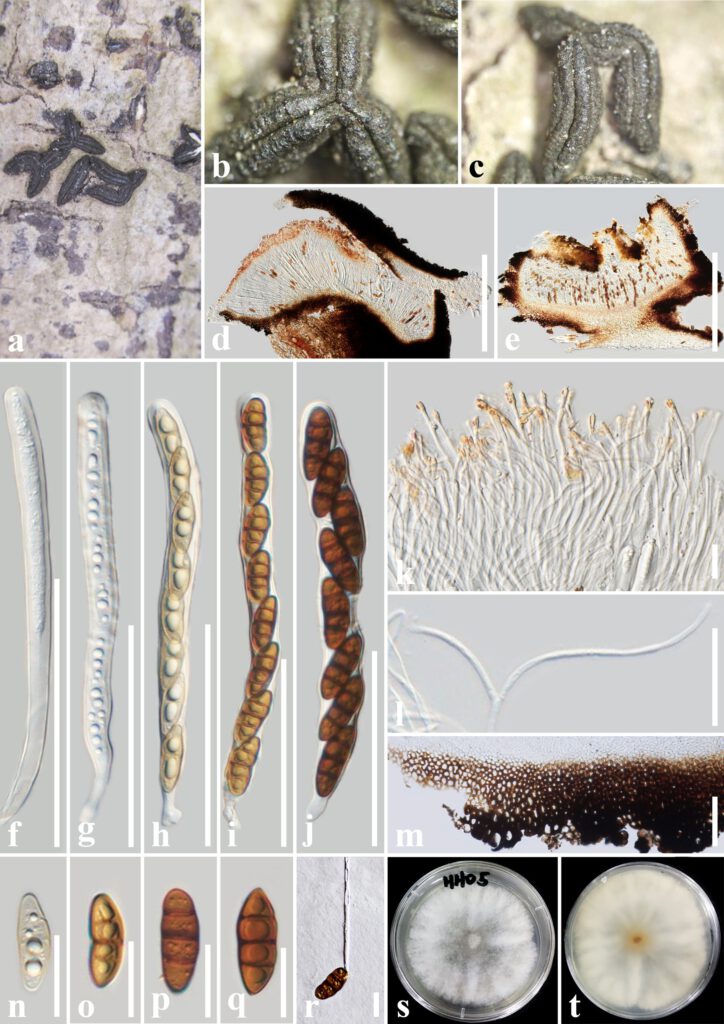Rhytidhysteron yunnanense T.Y. Du and Tibpromma, sp. nov. (Figure 4)
MycoBank number: MB; Index Fungorum number: IF; Facesoffungi number: FoF 12960;
Etymology: Named after the region, where this sample was collected, Yunnan.
Holotype: HKAS 122696
Saprobic on decaying wood of Rhus chinensis (Anacardiaceae). Sexual morph: Ascomata 1900–3000 μm long × 400–800 μm wide × 300–600 μm high (x̅ = 2510 × 625 × 455 μm, n = 5), hysterothecial, solitary to aggregated, mostly aggregated, semi-immersed, navicular to irregular, black, apothecioid, rough, each hysterothecia has two parallel striate parallel to the longitudinal slit, and slight perpendicularly striate, elongate and depressed, compressed at apex, longitudinal slit no opening. Exciple 60–180 μm wide, composed of dark brown, thick-walled cells of textura globulosa, outer layer brown to dark brown, inner layer pale brown to hyaline. Hamathecium comprising 1–2.5 μm wide, dense, hyaline, septate, branched, cellular pseudoparaphyses, forming a yellow epithecium above asci when mounted in water, and becoming hyaline epithecium above the asci when mounted in 10% KOH, while appendages turn dark. Asci (205–)215–250(–265) μm × 12–16(–17) μm (x̅= 230 × 14 μm, n = 20), 8-spored, bitunicate, cylindrical, short with club-like perdicel, rounded at the apex, with an ocular chamber, J–. Ascospores 28.5–36 μm × 11–14.5 μm (x̅= 32.5 × 13 μm, n = 30), uni-seriate when mature, hyaline when immature, becoming reddish-brown to brown when mature, ellipsoidal to fusoid, straight or curved, rounded to slightly pointed at both ends, 3-septate, guttulate, smooth-walled, without the mucilaginous sheath. Asexual morph: Undetermined.
Culture characteristics: Ascospores germinating on PDA within 24 h and germ tubes produced from one or both ends. Colonies on PDA reached a 6 cm diameter after two weeks at 28°C. The colony velvety, circular, slightly raised, with a filiform edge, white on the forward and white in reverse.
Material examined: China, Yunnan Province, Honghe Prefecture, Honghe County, on decaying wood of Rhus chinensis Mill. (Anacardiaceae), 8 December 2020, T.Y. Du, HHD5 (holotype, HKAS 122696, ex-type living culture, KUMCC 21-0485, living culture, KUMCC 21-0486).
Notes: Rhytidhysteron yunnanense was closely related to Rhytidhysteron mesophilum Cobos-Villagrán, R. Valenz, Hern.-Rodr., Calvillo-Medina & Raymundo and formed a well-supported clade (90% ML/0.92 PP). However, R. yunnanense is distinct from R. mesophilum in having ascomata navicular to irregular, each hysterothecia has two parallel striate parallel to the longitudinal slit, and slight perpendicularly striate, and longitudinal slit no opening, while R. mesophilum has boat-shaped ascomata, with perpendicularly striate which perpendicular to longitudinal slit, and longitudinal slit opening (Cobos-Villagrán et al. 2021b). In addition, the asci and ascospores size of R. yunnanense are smaller than those of R. mesophilum (asci: 230 × 14 μm vs 267–282 × 15.5–16 µm, ascospores: 32.5 × 13 μm vs 44.2 × 13.6 μm) (Cobos-Villagrán et al. 2021b). Moreover, according to the comparison results of different gene fragments, R. yunnanense is different from R. mesophilum in LSU (12/790 bp, 1.52%) and ITS (28/651 bp, 4.30%) genes (≥1.50%). Therefore, in this study, R. yunnanense is introduced as a new species.
Moreover, in the previous study of the genus Rhytidhysteron, ascomata has transverse-striate, perpendicular to longitudinal slit, and in this study, it is the first time to find parallel striate, parallel to longitudinal slit.

Figure 4. Rhytidhysteron yunnanense (HKAS 122696, holotype). a-c Appearance of hysterothecia on the host. d, e Vertical section through hysterothecium. f-j Asci. k Epithecium mounted in water. l Pseudoparaphyses. m Exciple. n-q Ascospores. r A germinating ascospore. s, t Colony on PDA medium (after one week). Scale bars: d, e = 500 μm, f-j = 100 μm, k, l, n-r = 20 μm, m = 50 μm.
